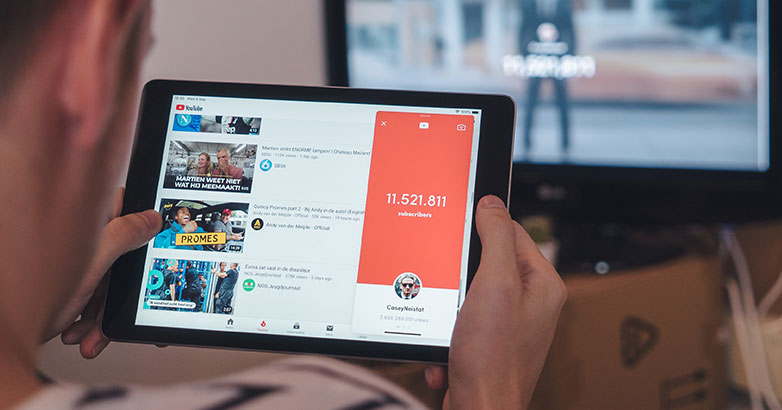
As everything in our lives has become more digital, so too has marketing. It’s in everything from social media advertising to email marketing and more.
In this article, we will go into more detail on each of the seven digital marketing services introduced above. We’ll also augment this information with relevant case studies, stats, and benefits. By the time you’re done reading, you should know which forms of digital marketing might suit you best.
Digital stategies include the following:
- • Sales and lead generation websites
- • Content marketing
- • Search engine optimization (SEO)
- • Paid advertising (AdSense, YouTube, remarketing ads, pay-per-click, and more)
- • Social media marketing
- • Video marketing
- • Email marketing

What Are Digital Marketing Services?
Let’s begin with a definition.
Digital marketing services are those that are reliant on modern tech such as the Internet. These services may employ the use of online advertisements, websites, social media platforms, apps, email, and more.
If you’re thinking of seeking services, you may wonder, what else do these services encompass?
This instantaneous means of communication can lead to much faster results, such as conversions and purchases, when compared to more traditional marketing.
Digital marketing is applied in both the business-to-business (B2B) and business-to-consumer (B2C) spheres. Sometimes, the way these businesses use digital marketing is very similar and other times, less so.

The Forms of Digital Marketing for B2B and B2C Companies and Their Benefits (Now with Case Studies)
In the intro, we mentioned seven different forms of digital marketing. We want to talk more about these now, including what each is, how clients use them (including B2B and B2C businesses), and the benefits. We’ll also share case studies for some of these digital marketing services.
Sales and Lead Generation Websites
Every business, from B2Bs to B2Cs, needs to generate leads. These potential new clients act as the company’s lifeblood, converting into customers and increasing revenue. One such way to attract leads is through the design of your website. It should be optimized so leads can easily find what they want.
The content should also be highly targeted to attract more qualified leads who may be willing to buy.
Financial company St. Clair CPA Solutions sought the services of Mediaboom for a website redesign. They wanted something that would draw in new clientele and keep them there. By updating their site map so it was more navigable, publishing keyword-driven and tailored content, and utilizing a mobile-friendly design, St. Clair achieved its results.

Not stopping there, Mediaboom also instituted CTAs across the site and did an SEO overhaul that focused on targeting more local clientele.
Landing pages and lead generation sites are two major tools of B2B industries, with 68 percent using these sites, found Marketo. Whether you want to attract more general leads or filter them through tailored content, a lead gen website is the way to go.
Here’s a recent case study that shows the value of landing pages (and referrals). Men’s razor brand Harry’s was about to launch its product. To drum up interest and grow its email list, the company made a landing page.
This netted them 100,000 email addresses.
Besides just collecting emails, Harry’s also asked for referrals. If their audience participated, they earned free stuff, mostly razors. Yes, this was expensive, but it also netted Harry’s 65,000 registrations.
This accounted for 77 percent of the total amount of email subscribers they got.

Content Marketing
Content is still king, and it’s going to be that way for the foreseeable future. This form of marketing includes writing enticing email copy, producing landing page content, and creating blog posts. Visual content is included as well.
Content marketing is another one of those digital marketing services that benefits both B2B and B2C companies. Well, those companies that use it.
Content Marketing Institute data from 2019 uncovered that content strategies are lacking for B2C brands. Only 38 percent of these companies have a content plan. The numbers were slightly more dismal for B2B companies, as just 37 percent of them had a content strategy in place.
If you count yourself among them, then content marketing is certainly a service you’d be interested in. After all, through tailored, targeted content, you can achieve such goals as:
- • Earning more email list opt-ins (through pop-ups that appear midway down a blog post)
- • Increasing revenue (by recommending and linking to products)
- • Establishing yourself as an authority (by posting valuable and unique content, especially the sharable kind like infographics)
- • Engaging with your audience (by sharing blog posts to social media, responding to blog comments, and more)
- • Converting more customers (with crisp landing page copy)
- • Strengthening your brand and making it more recognizable (a must in B2B marketing)

Search Engine Optimization
SEO. Three little letters can mean so much. Every company wants to end up on the first page of search engine results, and not only the first page, but the first result.
That’s especially true considering Lyfe Marketing reports that few Internet users—only seven percent—will ever get to the third page of a search.
Your SEO goals are different if you’re a B2B vs. a B2C company. You still want to be seen and get to number one, but you have a slightly more specific audience as a B2B company. This will see you using low-volume keywords and expecting much less search volume compared to B2C businesses, as that’s just the nature of your industry.
B2B companies also want to frame their SEO in such a way that instead of incentivizing the consumer to buy, they’re positioning their brand. Why?
In the realm of B2B, purchasing decisions happen much more slowly than in B2C. A B2B buyer may mull over a purchasing decision for a while before acting on it. By making your brand a top result on a site like Google, when the consumer decides they do need the B2B company’s services, they’ll know just where to go.
One way to get to the top of a SERP page as a B2B company is to write content that answers the questions that show up in Google searches. This establishes your authority and could bring in new clientele.
Here’s a case study that shows the importance of SEO as a digital marketing service. Mediaboom assisted Clarity Software Solutions in achieving their SEO goals. This healthcare company worked with Mediaboom for more than three years. Not only did they get their SEO enhanced, but their website development and content strategy as well.
In those three years, Clarity Software Solutions has seen traffic growth of more than 250 percent, organic traffic increases of more than 300 percent, and a spike of over 1,200 percent in website conversions.
Further, the healthcare company also noticed its search engine visibility increase by 2.5x and their SERP ranking went up to at least 10.

Paid Advertising
It used to be billboards that caught our attention, then TV commercials. These days, it’s all about paid advertising on websites and social media platforms alike. You have all sorts of paid advertising options at your fingertips, such as using AdSense, YouTube advertising, remarketing ads, social media advertising, and pay-per-click.
Speaking of PPC, Google Ads especially can be quite advantageous to today’s businesses looking to drum up leads or boost brand recognition. Ad software brand WordStream mentions that you can earn $2 for each dollar you put forth in your Google Ads budget.
Another stat attesting to the power of Google ads found that more than half of consumers, 64 percent, will engage with a Google ad when shopping, clicking the ad. This is especially handy for B2C industries.
Outside of Google, PPC ads can deliver big results.
The same data notes how it’s possible to increase brand awareness at a rate of 46 percent through PPC ads.
B2B companies, take note!
Further, most shoppers who see a PPC ad, up to 52 percent, will then contact the business running the ad. When these people arrive on your website, they may be more prepared to make a purchase than even organic search visitors.
Facebook Ads are another advertising venture to pay attention to. It’s estimated that by 2020, businesses may spend $25.56 billion on Facebook advertising alone. This graphic shows the upward trend of Facebook ad spending since 2016.
eMarketer, in a similar graphic, reviewed general digital ad spending from 2016 to 2021. While the ad spending for 2020 and 2021 are projections, the trend goes upward. In 2020, it’s estimated marketers will spend $341.81 billion on digital ads. In 2021, it may be as much as $375.80 billion.

Social Media Marketing
The wide world of social media appeals to practically everyone, from younger generations to luxury markets and nearly any niche. The big kings of social media are Facebook, Twitter, and LinkedIn, with very viable platforms like Pinterest, Instagram, and YouTube always gaining in popularity.
Social media marketing can be used to:
- • Brand your company and build recognition
- • Grow your audience
- • Attract new leads
- • Engage with customers
- • Introduce new products/services
MarketingCharts.com, in a 2018 graphic, found that 37 percent of consumers got purchasing ideas after scrolling through social media. That’s even more than those who go on a retailer’s website, which was only 34 percent.
If your ads happen to be in the right place at the right time, or if you have enough social followers, those 37 percent could decide to buy from you.
In 2017, Social Media Examiner asked marketers which social platform they couldn’t go without. B2B industries said Facebook (43 percent), followed by LinkedIn (37 percent). B2C industries thought Facebook was even more crucial, as 72 percent said they would not want to go without it.

Video Marketing
Few online activities have grown to such the lofty levels of popularity as video marketing. A 2018 infographic from website builder states that, every day, five billion people watch videos on YouTube. On Facebook, consumers watch 100 million hours of daily videos.
While it can be uncomfortable to put yourself on camera (at least at first), both B2B and B2C industries can succeed with video marketing. Renderforest’s infographic also says that video marketing can increase web traffic at a rate of 41 percent and revenue at a rate of 49 percent.
Videos can stick in people’s heads, too, for quite a long time. Crisp Video reports that many consumers, up to 80 percent, may recall a video even a month after seeing it!
Now, you may worry that you would go to all the trouble of writing a script, finding someone to be in your video, choosing a location, shooting, editing, and posting only for no one to watch. That’s not so much the case, either. This 2018 graphic from MarketingCharts.com notes that video completion is up across the board.
For 15-second ads, 72 percent of people watch them all the way through. In 2015, only 47 percent of people did. Longer ads running 30 seconds had a completion rate of 67 percent in 2017. Overall, completion rates were about 70 percent that year.
Surely, the numbers have only increased since then.

Email Marketing
Last, but certainly not least, we’ve got email marketing. After building a targeted website and landing pages to find leads, you then invite them to become email subscribers. Once they subscribe, you nurture the relationship to encourage a buying decision. The relationship continues to earn repeat buys and build a long-term professional bond.
While the intricacies of B2B vs. B2C email marketing may differ somewhat, the above premise is still the same for both.
Conclusion
Digital marketing services include areas like advertising, lead generation, social media marketing, SEO, video marketing, email marketing, and more. While the applications of these services between B2B and B2C companies can sometimes vary, what doesn’t change is the wealth of benefits.
If your company was on the fence about what Mediaboom’s digital media services can do for you, this article shows that a good marketing campaign is not just beneficial, but vital.
The post Digital Marketing Services: The Various Forms and Their Benefits appeared first on Mediaboom.
